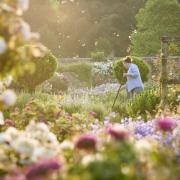Ornamental onions, alliums, give a bold, architectural presence to the garden, woven through borders, lining paths and en masse in blocks. Although most have rich purple globular clusters of flowers, there are also varieties with white, blue, mauve, pink, yellow and burgundy flowers, some with pendulous bells, as well as the rather lovely two-toned drumstick alliums. You can have different alliums blooming from late spring, through summer, and into autumn with their statement seedheads, which are also attractive. When you’re out visiting gardens look out for some lovely ideas of how to use these popular bulbs in your own garden. Take photographs and note ideas so you will be ready to plant. Bulbs are readily available in autumn but you can also buy plants in flower in spring or early summer. To track down particular cultivars try the RHS Find a Plant or visit specialist nurseries such as Hardy’s Cottage Plants in Freefolk or Everton Nurseries in Lymington.

For sheer impact it’s hard to beat the power of the ever-popular purple allium varieties and cultivars. Purple is a rather special colour; hot and cold at once, being formed by a balance of red’s stimulation and blue’s calm. It can uplift and encourage creativity or relax and soothe the mind. Luxurious, rich purples add the glam factor to hot border schemes and its softer tones are perfect for romantic, harmonious schemes. It’s a colour readily found in nature and in fact most of its varied shades have names derived from flowers or fruits – just think of lavender, violet, lilac, mulberry, plum and aubergine. Purple flecked through golds or particularly with astringent lime greens is eye-catching; tonal mixes of mauves are soft and soothing and lavender mixed with crimson roses evokes romance.

A much-emulated use of alliums is to line them along paths through laburnum tunnels, the exciting combination of astringent yellow with rich purple is truly eye-catching. The fresh greens of spring foliage on shrubs and trees, underplanted with alliums en masse also looks stunning, as does the sprinkling of alliums though long grass or later varieties mixed in flower borders, contrasted with swaying ornamental grasses and late season perennials. Alliums are versatile and adaptable, pretty trouble free and add style and personality to the garden. A word of warning – once you start admiring them and grow some, you will definitely want some more! The most popular and first cab off the rank is the earliest-blooming Allium ‘Purple Sensation’. They are a great choice as they are a clear raspberry-purple, the flowers will last for up to two weeks in the garden, multiple over time and look lovely amongst other plants flowering at the same time, such as irises and nepeta.


For larger spheres, the size of a tennis ball to a bowling ball, look for what are termed the border alliums, including ‘Globemaster’ and ‘Gladiator’, and the white ‘Mount Everest’. These stately alliums really stand out in a border, followed by the impressive seedheads, which continue to add their presence through the season. Try romantic, soft combinations with roses, peonies, delphiniums, lavender and campanulas, along with silvery foliaged artemisia, for charming effects. Allium christophii, the star of Persia, with its spherical silvery-lilac heads, the size of a small football, shines out in many gardens through May to June, and then its sparkler seedhead is almost as much admired. Grow them in clumps at the front of a border and they can also look wonderful in containers. In addition to the spherical types, the burgundy drumstick varieties, Allium sphaerocephalon, are invaluable for late summer interest, especially in drifts of prairie style planting. Partner them with feathery, ethereal grasses such as pennisetum, miscanthus and molinia, along with bright torches of kniphofia and deep maroon dahlias.

To guide your selection, think about the effect you are after, the size and colour of the blooms, the height they’ll reach for positioning where they will be admired, and of course your growing conditions of soil and micro-climate. In general the spherical types give the best structure in borders and are readily combined with harmonious or contrasting tones and shapes from herbaceous companions. Alliums suit any style of garden so feel free to get creative, whether you’re looking for a dramatic or a softer look, there are sure to be choices you’ll adore and look forward to each year when they pop up again.

• Hardy’s Cottage Garden Plants, Freefolk, RG28 7FA hardysplants.co.uk
• Stewarts Abbey Garden Centre, Titchfield PO15 5RB stewarts.co.uk
• Fairweather’s Nursery, Beaulieu, SO42 7YR fairweathersnursery.co.uk
• Everton Nurseries, Lymington, SO41 0BF evertonnurseries.co.uk

Gardens to visit
• West Green House Gardens, Hartley Wintney, RG27 8JB westgreenhouse.co.uk
• Houghton Lodge, nr Stockbridge, SO20 6LQ houghtonlodge.co.uk
• Sir Harold Hillier Gardens, Amplefield, Romsey, SO51 0QA hilliergardens.org.uk
• How Park Barn, Kings Somborne, SO20 6QG ngs.org.uk
• Colemore House Gardens, Colemore, GU34 3RX ngs.org.uk

Get the look
• Plant bulbs in autumn or plants can be bought in spring and summer.
• Plant in free-draining soil in a sunny spot. Avoid cold, exposed or waterlogged conditions.
• Dig over the soil and remove weeds before planting.
• You can deadhead spent blooms or leave the seedheads after flowering to provide architectural interest.
• Alliums make attractive cut flowers, with a long vase life of up to two weeks and can also be dried. To minimize the smell of spring onions when you cut the stems, plunge in water and rinse before arranging.
• Alliums are perennials so will flower year after year. Some varieties will spread and can be divided after flowering, others will need to be added to each year.
• Allow bulbs to die down naturally as they need their foliage to produce energy for the following year’s flowers.
• To disguise dying foliage position them where low growing plants will act as cover.
• Feed with a general fertiliser in spring.




























